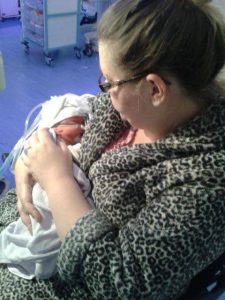 Many parents, as well as individuals with SA/CRS themselves, have questions about whether this condition resulted from an inherited gene, whether it can occur with other children in the family, or whether it can be passed down from parent to child. Exploring cause is a natural process in learning about and accepting the diagnosis. A letter to parents, here, describes some important considerations for parents in this journey.
Many parents, as well as individuals with SA/CRS themselves, have questions about whether this condition resulted from an inherited gene, whether it can occur with other children in the family, or whether it can be passed down from parent to child. Exploring cause is a natural process in learning about and accepting the diagnosis. A letter to parents, here, describes some important considerations for parents in this journey.
The question of whether or not SA/CRS is a genetic condition is a complex question. There is not much research done about SA/CRS, it is rare and difficult to gather a large number of people to study, and research done in the past has sometimes been confirmed as incorrect by more recent research. For example, it was once thought to be associated with Sirenomelia (mermaid syndrome), but now we know that is not the case. SA/CRS possibly occurs for many different reasons. Some of the reasons it is thought to occur may be genetic and some may be environmental reasons. It may be due to a combination of both genetic and environmental factors. For the most part, no one knows the cause, and the cause is not the same for everyone.
The question is also complicated because the word “genetic” has several different meanings and may be used differently by researchers, medical professionals, and the lay public. For more information on genetics, see Help Me Understand Genetics.
A Genetic “cause” for a condition may mean:
- An genetic trait passed down through one or both family members through several generations. This inherited trait may not be noticed in the parent(s) but the parents can be carriers of a recessive trait, so the trait only appears when both parents are carriers and possibly only in some of their offspring. Some forms of SA/CRS do have a known inherited genetic cause has been identified (See Curranrino Traid).
- It is also possible that an inherited trait is a “genetic predisposition“, meaning the trait does not occur unless certain environmental factors or combinations of genetic factors are also present. For most forms of SA/CRS, there is not enough research to indicate what, if any, genetic contributions might be, or what, if any, environmental contributions might be.
- A “genetic” disorder can mean that the child has a mutation in every cell in the body but the parents do not, and there is no family history of the disorder. These “de novo” or “new” changes in the gene(s) may occur for the first time when the fertilized egg and sperm cells unite. It is often impossible to tell exactly when a de novo mutation happens. This might be true for SA/CRS, but again there is not enough research to indicate what the genetic contribution might be.
- Some “genetic” mutations can occur later in a person’s life and in cells other than the sperm and egg (somatic cells). These changes can be caused by environmental factors Acquired mutations in somatic cells cannot be passed to the next generation.
Research is ongoing, and there are only a very few research studies being done on this condition. Some information published in prior studies has later been proven invalid because of advances in DNA testing that was not possible in prior years. Therefore, very different information may be reported depending on the date of the research.
Studying the genetics of SA/CRS is a complicated for several reasons:
- The condition is rare, so studies are typically done on single cases or very small populations, which means that broad claims related to genetic factors cannot be determined easily.
- Genetic studies of larger populations costs millions of dollars, so funding is also a barrier.
- Among the more physically impacted individuals, with more absence of the spine and spinal cord, childbirth is infrequent and is not possible for some. There may be physical complications that make pregnancy more difficult for those with SA/CRS to have children. That makes it challenging for researchers to study genetic histories for this condition.
- SA/CRS is a broad description of the absence of a physical feature, which may exist as part of other syndromes or conditions that are known to be genetic (Curarrino Triad) or of unknown cause. One such condition is VACTERL Association. VACTERL Association is a grouping of birth conditions impacting multiple parts of the body, These combinations (vertebral defects, anal atresia, cardiac defects, tracheo-esophageal fistula, renal anomalies, and limb abnormalities) happen together more often than it would happen due to chance alone, but for which no specific cause has been determined. A small number of VACTERL association cases have been linked to mutations in FGF8, HOXD13, ZIC3, PTEN, FANCB, FOXF1, and TRAP1 genes and mitochondrial DNA.
- MRI studies indicate two categories of SA/CRS. These categories describe the formation and the spine and spinal cord. These two types of SA/CRS may have different causes.
- Group 1: The conus medullaris is blunt and terminates above the normal level; there is sometimes an associated dilated central canal or a cerebrospinal fluid–filled cyst at the lower end of the conus. These patients have major sacral deformities
- Group 2: The conus medullaris is elongated and tethered by a thickened filum terminale or intraspinal lipoma and ends below the normal level. Neurologic differences are more severe in this group
Despite Many Unknowns, There are Some Things We Know:
- In four known cases of individuals with SA/CRS (female) which included the high lumbar region who did give birth, none of their children had the condition of SA/CRS.
- Similarly, in pregnancies of women with SA/CRS that impacted only the lowest (sacral) region of their spines, there is no known report of any of their offspring had SA/CRS.
- In a review of literature and iSACRA group survey, only three known cases are reported in which two children in the same family were both born with the condition of SA/CRS. In all other known families of two or more children, only one child in the family was born with SA/CRS.
- In reports of twins, only two known cases indicate both of the twins had SA/CRS. In most cases of twins, only one twin has the condition.
- In families surveyed by iSACRA who went to genetics testing related to SA/CRS, no genetic indicators were found to explain the condition. In some cases other genetic factors were found for different conditions, meaning the child has SA/CRS and also one or more other conditions.
- Maternal diabetes is linked in some way, and diabetes itself may be genetic, but the link between SA/CRS and maternal diabetes is not fully understood. Most children born with SA/CRS do not have diabetic mothers.
- SA/CRS does not happen more frequently in males than females.
The answer to the genetic question is unclear
In summary, it cannot be confirmed that SA/CRS is genetic. Most trips to genetic counseling do not reveal any information related to this condition. However, because sacral agenesis describes a physical structure (the absence of the sacrum) there are genetic conditions which may include that same absence of this physical structure along with other features of that genetic condition, such as Currarino Triad. Perhaps there is some type of environmental influence but the specifics are unclear. It is likely that there are several different causes of SA/CRS, and there are many variations of the condition. The condition is not tied causes of spina bifida, though some individuals with SA/CRS have both. It is not related to “mermaid syndrome”, though early research associated the two. Parents with concerns about having a second child with SA/CRS should note that the indicators are less than 1/1000 chances of a second child being born with SA/CRS in the same family. It is not uncommon for new parents to wrestle with emotions related to blame and guilt and articles under the parent section and the diagnosis section of this site may be helpful.
Genetic Research:
https://bmcmedgenet.biomedcentral.com/articles/10.1186/s12881-016-0359-2
